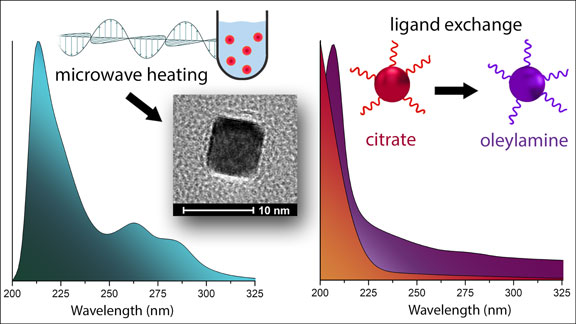Crossref Citations
This article has been cited by the following publications. This list is generated based on data provided by
Crossref.
Chin, Clare Davis-Wheeler
Akbarian-Tefaghi, Sara
Reconco-Ramirez, Juana
and
Wiley, John B.
2018.
Erratum to: Rapid microwave synthesis and optical activity of highly crystalline platinum nanocubes - ADDENDUM.
MRS Communications,
Vol. 8,
Issue. 4,
p.
1483.
Li, Yan
Yun, Kum-Hee
Lee, Hyeri
Goh, Sung-Ho
Suh, Yang-Gun
and
Choi, Yongdoo
2019.
Porous platinum nanoparticles as a high-Z and oxygen generating nanozyme for enhanced radiotherapy in vivo.
Biomaterials,
Vol. 197,
Issue. ,
p.
12.
Engelbrekt, Christian
Crampton, Kevin T.
Fishman, Dmitry A.
Law, Matt
and
Apkarian, Vartkess Ara
2020.
Efficient Plasmon-Mediated Energy Funneling to the Surface of Au@Pt Core–Shell Nanocrystals.
ACS Nano,
Vol. 14,
Issue. 4,
p.
5061.
Davis-Wheeler Chin, Clare
Lee, Harold O.
Griego, James J. M.
and
Treadwell, LaRico J.
2021.
Liquid crystalline behavior and photoluminescence of lanthanide decanoate nanoparticles synthesized by microwave radiation.
Dalton Transactions,
Vol. 50,
Issue. 15,
p.
5269.
Chin, Clare Davis-Wheeler
Treadwell, LaRico J.
and
Wiley, John B.
2021.
Microwave Synthetic Routes for Shape-Controlled Catalyst Nanoparticles and Nanocomposites.
Molecules,
Vol. 26,
Issue. 12,
p.
3647.
Howard, Tyler V.
Berry, Keith R.
and
Roper, D. Keith
2021.
Initial dynamic thermal dissipation modes enhance heat dissipation in gold nanoparticle–polydimethylsiloxane thin films.
Journal of Thermal Analysis and Calorimetry,
Vol. 143,
Issue. 6,
p.
3899.
Ahmad Shah, Noor Aisyah
Demon, Siti Zulaikha Ngah
Diauddin, Farah Nabila
Kasim, Norherdawati
Abdullah, Norli
and
Krishnan, Ganesan
2021.
The Study of Platinum Coated Carbon Nanotubes as Third-Order Nonlinear Optical Materials.
Solid State Phenomena,
Vol. 317,
Issue. ,
p.
166.
Lazar, Oana Andreea
Moise, Călin Constantin
Nikolov, Anastas Savov
Enache, Laura-Bianca
Mihai, Geanina Valentina
and
Enachescu, Marius
2022.
The Water-Based Synthesis of Platinum Nanoparticles Using KrF Excimer Laser Ablation.
Nanomaterials,
Vol. 12,
Issue. 3,
p.
348.
Zhang, Zhanzhan
Yang, Guangxing
Wang, Hongjuan
Cao, Yonghai
Peng, Feng
and
Yu, Hao
2022.
Controllable Surfactant‐free Synthesis of Colloidal Platinum Nanocuboids Enabled by Bromide Ions and Carbon Monoxide.
ChemElectroChem,
Vol. 9,
Issue. 12,
Zhang, Mengke
and
Guo, Xiaodong
2022.
Gold/platinum bimetallic nanomaterials for immunoassay and immunosensing.
Coordination Chemistry Reviews,
Vol. 465,
Issue. ,
p.
214578.
Padmavathi, R.
Kalaivanan, C.
Raja, R.
and
Kalaiselvan, S.
2022.
Antioxidant and antimicrobial studies of silver nanoparticles synthesized via chemical reduction technique.
Materials Today: Proceedings,
Vol. 69,
Issue. ,
p.
1339.
Davis-Wheeler Chin, Clare
Fontenot, Patricia
Rostamzadeh, Taha
Treadwell, LaRico J.
Schmehl, Russell H.
and
Wiley, John B.
2022.
Platinum@Hexaniobate Nanopeapods: A Directed Photocatalytic Architecture for Dye-Sensitized Semiconductor H2 Production under Visible Light Irradiation.
ACS Applied Energy Materials,
Vol. 5,
Issue. 12,
p.
14687.
T. V. M., Sreekanth
Kisoo, Yoo
and
Kim, Jonghoon
2022.
Temperature‐dependent synthesis of
Mn
3
O
4
nanostructures by microwave irradiation method for high‐performance supercapacitors
.
International Journal of Energy Research,
Vol. 46,
Issue. 2,
p.
1683.
Lazar, Oana Andreea
Nikolov, Anastas Savov
Moise, Călin Constantin
Mihai, Geanina Valentina
Prodana, Mariana
and
Enachescu, Marius
2023.
KrF excimer laser for Pt–NPs synthesis by PLAL in isopropanol solution and their use in a SERS application.
Journal of Materials Research and Technology,
Vol. 24,
Issue. ,
p.
7135.
Kori, Deepak K. K.
and
Das, Apurba K.
2023.
Engineering of Bimetallic Cu–Pt Nanostructures for the Electrochemical Ammonia Synthesis via Nitrate Reduction.
ACS Applied Engineering Materials,
Vol. 1,
Issue. 9,
p.
2386.
Andreea Lazar, Oana
Savov Nikolov, Anastas
Constantin Moise, Călin
and
Enachescu, Marius
2024.
Laser Ablation - Applications and Modeling.
